T1D-Plus
Find out about an exciting new way to trial new treatments for T1D
Facing the Future:
We reveal our latest report on T1D and ageing
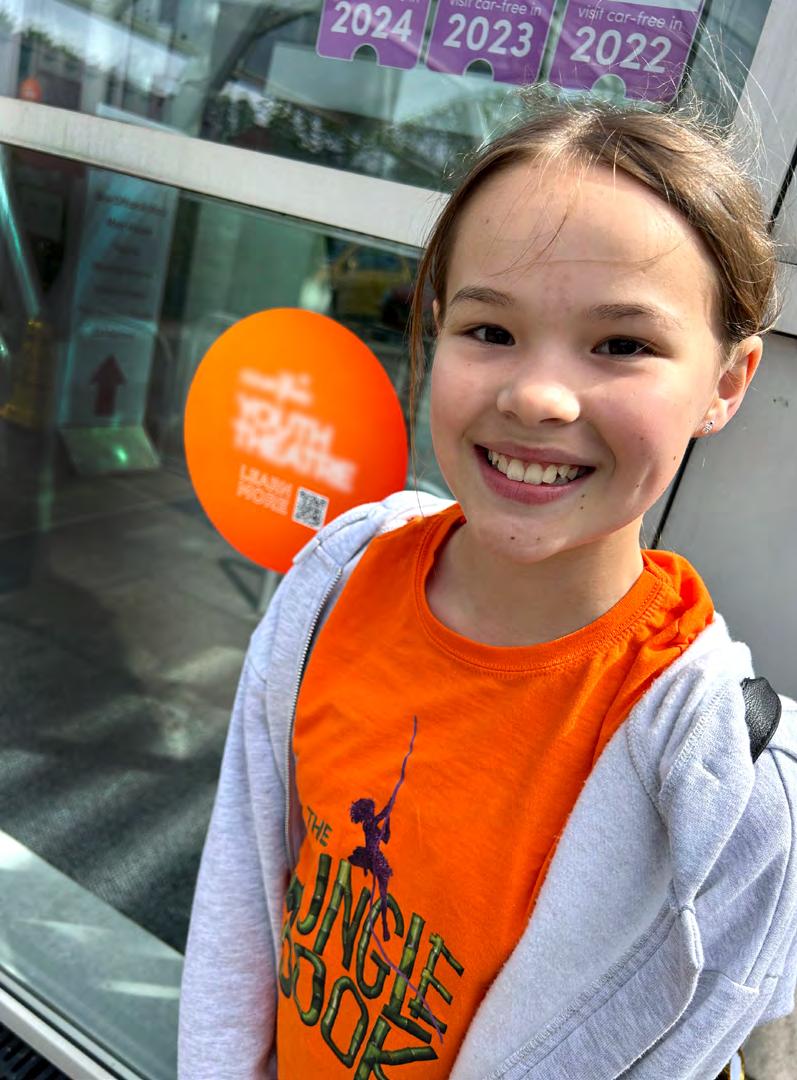
Say hello to Barbie with T1D, bringing style, awareness and representation to the community

Find out about an exciting new way to trial new treatments for T1D
We reveal our latest report on T1D and ageing

Say hello to Barbie with T1D, bringing style, awareness and representation to the community
whose journey with teplizumab offers a glimpse of what the future of T1D treatment could look like
Volunteering at Breakthrough T1D
We meet two of our incredible volunteers making a difference

If you’re living with type 1 diabetes, you’re eligible for a continuous glucose monitoring (CGM) system on the NHS, and may be offered a choice of system based on your individual preferences and needs.1 So, here’s a tick list to help make choosing the best system for you and your lifestyle, a little simpler:
BOTH DEXCOM ONE+ AND DEXCOM G7 GIVE YOU A RANGE OF BENEFITS
High and low alerts
A choice of 3 wear locations*,†,2,3
A waterproof sensor‡,§,2,3
The Dexcom Follow app||,2,3
– so you can share your glucose levels with up to 10 followers
AND DEXCOM G7 OFFERS ALL THESE EXTRAS, SHOULD YOU NEED THEM
Connects to a choice of insulin pumps
Connects directly to your Apple Watch¶,#,3
– so you don’t have to have your phone with you to receive CGM readings
Predictive alert
– warns you up to 20 minutes before you go low
Use the Dexcom Follow app||,3
– whilst on a Hybrid Closed Loop (HCL)
Screen widget
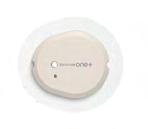
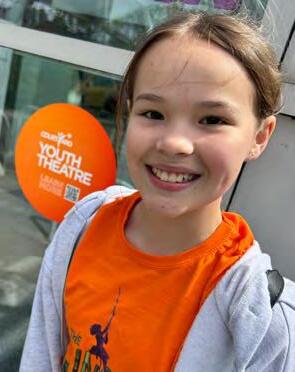

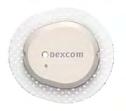

Welcome to the latest issue of Discovery, where we share the progress your support makes possible.
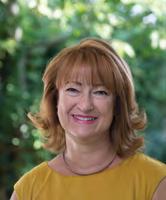
In this issue you’ll find out about our new report on type 1 diabetes and ageing, which calls for better care and support for older adults living with T1D. You’ll also learn about T1D Plus, a new platform trial designed to accelerate the way we test and deliver promising treatments. It’s a significant step towards faster research that reaches people with type 1 sooner.
We speak with a family whose child received teplizumab, a treatment made possible through the research that you have helped to fund. Their story is a powerful reminder of the reallife impact of our work.
We also catch up with Professor Matt Webber, a researcher supported by the Type 1 Diabetes Grand Challenge. His innovative work on next generation of insulins has the potential to transform daily life for many. In this issue we also speak to a couple of our dedicated volunteers, who share what drives them to help at our events and out in the community. Finally, don’t miss our feature on the new Barbie with T1D, a milestone for awareness and representation.
As always, I would like to say a big thank you to all the everyone who shared their experiences and to everyone who gives their time and energy to our mission. With your continued support, progress is not just possible, it’s happening.
Managing Editor: Odette Myall
Contributors: Ros Grey, Kemi Disu, Lucy Mason Pearson, Sophie Stephenson
Cover image: Imogen Norman Breakthrough
Enhanced Bluetooth with Rapid Reconnect see the
Speak to your diabetes team about the best Dexcom CGM for you.

This spring, we launched a bold 10-year strategy focused on driving meaningful progress in T1D research, treatment and advocacy. With your continued support, we are making breakthroughs happen by building on past successes and pushing forward research into diseasemodifying and cellular therapies.
Our aim is to create more treatment options, improve access, and ensure people living with T1D have the information and tools they need.
With increased investment here in the UK and internationally, we are working to transform how T1D is understood. That includes exploring ways to slow or even delay the onset of symptoms through earlier and more effective interventions. At the heart of this strategy is a commitment to bringing breakthroughs to the community. The voices and experiences of people living with T1D guide everything we do, from shaping research priorities to influencing policy and improving access to trusted information.
We are also focused on helping people manage T1D more confidently today. That means advocating for wider access to technology, expanding treatment pathways and making sure people know what is available and how to get it.
To achieve all of this, we are deepening engagement and support by working more closely with you, and with partners, policy-makers and healthcare communities. Together we can secure the funding and momentum needed to drive longterm change.
By making breakthroughs happen and bringing them to the people who need them most, we are taking the next steps toward better treatment and one day, cures.
‘What a cure feels like’ film wins award
Breakthrough T1D’s brand film, ‘What a cure feels like’ was named the People’s Choice Gold film in the £5 to £15m category at the Smiley Charity Film awards held in London on 20 March.
The Smiley Charity Film Awards is the world’s largest cause-based film campaign. It generates millions of additional views for entered films and ignites conversations on

social media and drives awareness for organisations involved.
Films are voted for by the public, and the films with the highest number of public votes become finalists. Congratulations and thank you to our supporters who shared their stories and participated in the film. Also, thank you to all of you who voted in the Smiley Charity Film Awards. The film continues to be viewed and shared across the world.

We are delighted to share that Karen Addington, CEO of Breakthrough T1D, has been awarded the Member of the Order of the British Empire (MBE) in the 2025 King’s Birthday Honours, for exceptional services to People with Type 1 Diabetes.
The award recognises Karen’s dedication and impact over the past 20 years at Breakthrough T1D. Under her stewardship, Karen has kept the search for a cure firmly at the heart of our mission, overseeing a quadruple increase in investment in research, and championing innovative advances in treatment, such as continuous glucose monitoring and hybrid closed loop systems.
“I’m truly honoured and a little overwhelmed to receive this recognition. But this award really belongs to the incredible type 1 diabetes community and the dedicated team I’m lucky to work alongside.” said Karen. “I’ve just played a small part in something much bigger, supporting people living with T1D and pushing for progress in care, understanding and research. I’m grateful every day to be part of this important work.”
We are sure that you will all join us in sending Karen our warmest congratulations.
New research, supported by Breakthrough T1D, shows enteroviral infections may contribute to the development of T1D
We know developing T1D happens over time and that there are lots of things that contribute to a person developing the condition.
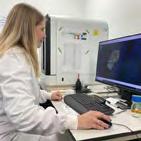
When a person’s genetic risk is combined with a ‘trigger event’, the immune system starts to attack healthy beta cells, bringing on a higher risk of developing T1D in the future. Now, the largest ever study examining human pancreas tissue for signs of viral infection has indicated that one such trigger event – infections caused by a family of viruses called enteroviruses – may trigger the immune system to start attacking insulin-producing cells in people with certain genetic risks. 83% of donors diagnosed with T1D but still able to produce low levels of insulin tested positive in two or more enterovirus-related tests, compared with 0% in the group without T1D. This research brings us a step closer to determining if vaccination or anti-viral treatments could have a role in preventing T1D in genetically at-risk individuals.
Two topics of research from the American Diabetes Association (ADA) conference in June 2025 have sparked an interest in the global T1D community. Firstly, Vertex has found that ten out of 12 participants in their trial no longer required insulin once they had received an infusion of lab-grown beta cells. No participants had episodes of severe hypoglycemia and they all spent 70% of the time in their target glucose range. They all had to use immunosuppressants to stop the cells being attacked by the
When we come together, we make change happen. Whether it’s volunteering our time, taking on a fundraising challenge, or making a donation, together we are improving the lives of everyone living with T1D
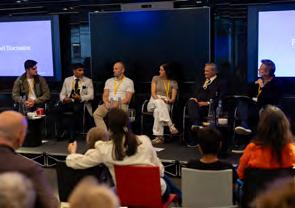
Our ‘Evening with T1D Sports Stars’ event in June, hosted by long time supporter Luke Sutton, featured some of the UK’s most prominent current and former sports professionals living with type 1 diabetes.
immune system. Secondly, Sana technology has used modified donor pancreas cells (islets) that were implanted into one participant’s arm. These islets contain beta cells, which produce insulin. This study showed that after six months the islets survived, and the beta cells continued to function. This participant did not have to take immunosuppressants during this time.
Further research is required to test safety and efficacy of both treatments.
Gary Mabbutt MBE, former England and premiership footballer and the first professional player with T1D, was joined by England Netballer Jess Shaw, Yorkshire Cricketer Jordan Thompson, former rugby player for the Worcester Warriors Chris Pennell and undefeated boxer Muhammad ‘DK’ Ali. It was an uplifting and inspiring event, and a chance for sport-loving children and their parents to hear how T1D should never be a barrier to achieving your dreams.
“The most important thing is that we keep saying it - no matter what you want to do in life, diabetes will not stop you.”
Gary Mabbutt MBE
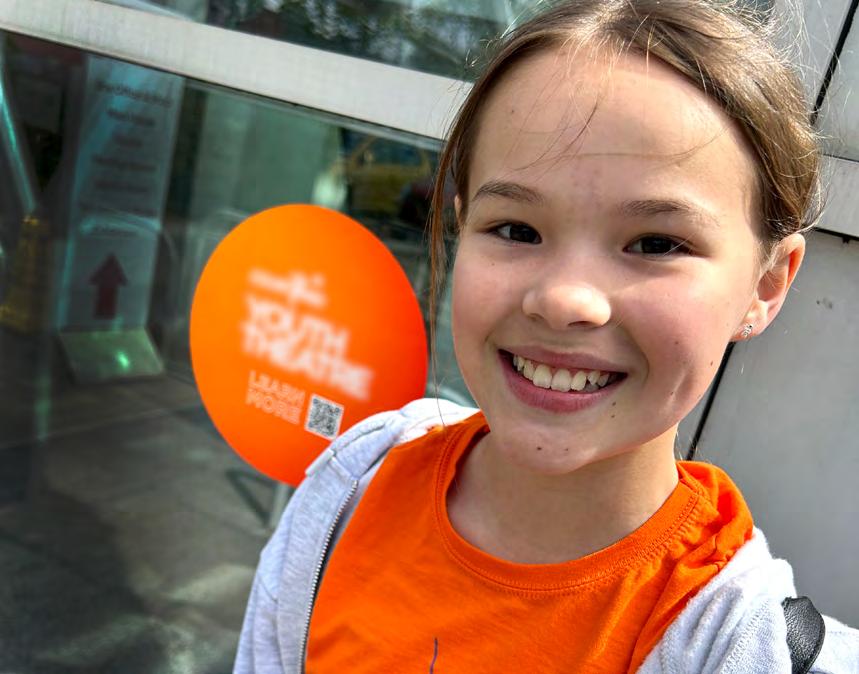
Amy has lived with type 1 diabetes for over 30 years. Now, she’s navigating a new frontier with her daughter Imogen, embracing early detection and emerging treatments to give Imogen the best chance at a T1Dfree adolescence.
My name is Amy, and I’ve lived with type 1 diabetes for over 30 years. I was diagnosed at 13, right in the middle of secondary school. I’d been losing weight, drinking squash by the litre and waking up in the night to wee. It was my mum who pushed the GP for the right tests. That’s how we found out.
I’ve seen how important scientific research is. Whenever I read studies involving thousands of people I wonder, where do they find all those volunteers? When I saw a social media post inviting children to take part in a research study focused on detecting T1D, I thought of my 11-yearold daughter, Imogen. Although she doesn’t have T1D, perhaps she could contribute to the research.
That how I came across the ELSA study, which is looking at how to detect T1D in its earliest stages, before insulin therapy is needed. Imogen’s initial test was in December 2023, and we didn’t hear anything more for a while. Then came a phone call, Imogen had tested positive for some of the protein markers linked to type 1 diabetes, but they weren’t sure how many. We were invited to Birmingham Children’s Hospital for further testing.
I was feeling cautiously hopeful, that just having one of the protein markers might mean she’d never develop T1D. But within weeks, more tests revealed she had three protein markers. She was in stage two of type 1 diabetes.

Imogen did a Glucose Tolerance Test (GTT), the only bit she really hated was the drink! Her glucose levels went up, and then it came back down again, but slowly. That was when we knew that she was in stage two of type 1 diabetes.
That means her body had already started attacking its own insulin producing cells. Now we knew that she would develop symptomatic type 1, we just didn’t know when. That’s when we met Dr Renuka Dias, a consultant in the ELSA study. She told us about teplizumab, a new treatment that can delay the onset of type 1 diabetes.
Teplizumab isn’t licensed for use in the UK yet, but it has been available in the US since 2022. However, under strict conditions, teplizumab could be made available to us on compassionate grounds. This is when treatments that haven’t been approved yet are offered to people outside of a clinical trial and can be used to help people access treatments that are still under development.
Imogen’s dad and I had lots of conversations. I’ve got lived experience of T1D, I know how tough it is. Gav doesn’t, but he’s lived through the alarms going off at night and sees what this condition means for our family. He brought a different perspective, asking the doctor questions to understand the benefits of taking teplizumab. I was very keen for Imogen to have the treatment, but I didn’t want to be a pushy parent. I got other people to ask her, when I wasn’t there, if she was nervous, or scared or she didn’t want to do it. She just took it all on the chin and did it all and went for it, it’s amazing.
The treatment was 14 days of daily infusions, so we arranged to stay in Birmingham during the Easter holidays in 2025.
It was nerve-wracking hearing about the risks, but the hospital team were brilliant. Imogen was given medication to prevent potential side effects. She had no serious issues, just a bit of a rash on her face on day one, which turned out to be from resting her cheek on her hand while on her phone!
Those first five days were hard. We were in the hospital for long stretches for observations. Around day five, Imogen’s T-cell levels dropped, and it looked like we might have to delay treatment. Thankfully, her blood test results showed her T-cell levels went back up and she carried on.
The whole thing was a new experience. We were on the Children’s Clinical Research Unit, which was a much more comfortable than I expected.
Imogen did really well through this entire process. That’s who she is as a person, always the first to put her hand up in school plays, never afraid of an audience. She’s got my ‘I’m just going to get on with it’ attitude and her father’s sense of humour.
If you told me before I was diagnosed that I could have this medicine for two weeks, and then I could delay it for up to three years if not more, would I have taken it? Absolutely. Other families might have a different story, there are lots of reasons why somebody might not want their child to have this, but you only know if you give it a try.
It was worth it. Not just for Imogen, but for improving our understanding of this treatment. Imogen might have been years away from symptomatic T1D, or we might just have caught her at the right time. We just don’t know.
As far as Gav and I are concerned getting her through her GCSEs without a diagnosis would be huge. Adolescence is horrendous anyway, if we can get her past that point, that’s going to be brilliant for her.
I’ve
seen how important scientific research is. Whenever I read studies involving thousands of people I wonder, where do they find all those volunteers?”
I talk openly about what we’ve done. With friends, other parents, and people in the type 1 community. Because I want others to know this isn’t scary. It’s hopeful.
Now Imogen is back at school, getting ready for her year six residential trip and drama performances. She’s not thinking about diabetes right now. She wants to be an actor or a writer. And that’s all that matters.
If you’ve been inspired by Amy and Imogen’s story, find out how you can get involved at breakthrought1d.org.uk/take-part
As we grow older, life with type 1 diabetes can become more complex, with new challenges around health, independence and support. At Breakthrough T1D, we want to shine a light on what ageing with T1D really looks like.
We’ve been listening to your experiences to help shape a new report, ‘Facing the future: Ageing with T1D and the need for change’* which is filled with recommendations on how to make things better. Together, we can make sure everyone with T1D gets the support they need at every age.
Thanks to advances in medical technology, a better scientific understanding of type 1 diabetes, and support from our incredible community which has allowed us to fund groundbreaking research, a generation of people living with T1D are living longer than ever before. This is something to be celebrated. However, it does bring about challenges, which now need to be addressed with urgency.
We’ve heard anecdotal stories from our community about the unexpected challenges that people living with T1D must navigate as they age and how they feel unsupported as they do so. This matched many of the findings of the ‘Getting It Right First Time’ report, published in 2020, which highlighted huge variations in the standard of care for those living with T1D whilst they were in hospital. We felt there was a need to conduct this market research, and to publish the report to get a better understanding of just how many of us are worried about our future and the unique challenges we begin to experience as we age. The ‘Getting It Right First Time’ report, published in 2020, highlighted huge variations in the standard of care for those living with T1D whilst they were hospitalised. In particular, it reported that there was often no formal training for staff on safe insulin administration, policies were in places that encouraged staff to take insulin away from
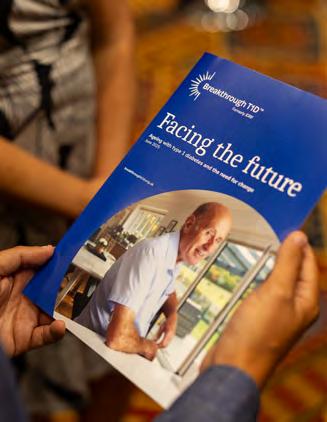
The views and experiences of the people we surveyed paint a concerning picture about ageing with T1D. The majority of participants revealed a deep sense of anxiety about their future
patients, and no formal process in place to ensure T1D specialists were involved in the care planning of an inpatient. We wanted to build on this report to see whether things had improved over the past five years and to get a better insight into the experiences of ageing with T1D.
To achieve this, we’ve been speaking to you about your experiences of ageing with T1D. We’re very grateful to the hundreds of you who took the time to respond to our survey and join the focus groups.
The views and experiences of the people we surveyed paint a concerning picture about ageing with T1D.
The majority of participants revealed a deep sense of anxiety about their future, especially around their ability to self-manage if their cognitive and physical abilities began to decline, and this was coupled with frustration over gaps in health and social care.
The people who had recently been admitted to hospital spoke of feeling isolated and misunderstood, describing fragmented systems that often fail to recognise the person behind the condition. In practice, this looks like healthcare staff having little understanding of how to safely manage T1D, how to safely administer insulin, ensuring that a diabetes specialist is involved in the care plan and being encouraged to remove insulin from patients.
“They wouldn’t let me have my insulin pens. They took it all away from me. It was like I was talking to people from another planet.”
Views on social care were similar, particularly with care homes. There was a sense among respondents that staff in care homes had very little understanding of T1D and would administer insulin in a ‘one size fits all’ approach. This left respondents feeling that care homes were simply not an option for them.
On a more positive note, technology such as continuous glucose monitors and hybrid closed loop systems (HCLs) were viewed very favourably and it was felt that technology had huge potential to mitigate many of the challenges that people were concerned about as they age. For people who had them, HCLs in particular were seen as offering comfort if they became less able to manage their type 1 as a result of declining cognitive or physical ability.
“I think I’m more optimistic than when I was first diagnosed. I thought I wouldn’t live past 30, or I would be blind, missing limbs or have severe complications. I think technology has enabled me to look after myself.”
This report is a starting gun for us, and we won’t stop until all of us can age with confidence and dignity. We will be working closely with bodies including the National Institute for Health and Care Excellence (NICE) and the Care Quality Commission (CQC) to enact change.
NICE set guidelines on what best practice looks like in healthcare and the guidelines that cover type 1 diabetes in adults are soon due for an update. We believe there are huge opportunities to drastically improve the care of people with T1D in hospital by improving these guidelines.
We will work with NICE during their consultation process to encourage them to make changes based on our recommendations. We are grateful to the community for sounding the alarm on these challenges and for providing us with your insight.
*This survey report was conceived, developed and led by Breakthrough T1D under its Access for All programme which is sponsored by Abbott, Dexcom and Insulet. Novo Nordisk, Vertex and Sanofi also provided sponsorship to Breakthrough T1D to support costs associated with this research and report but had no influence or involvement in the project.
If you want to find out more about our report visit breakthrought1d.org.uk/facingthefuture
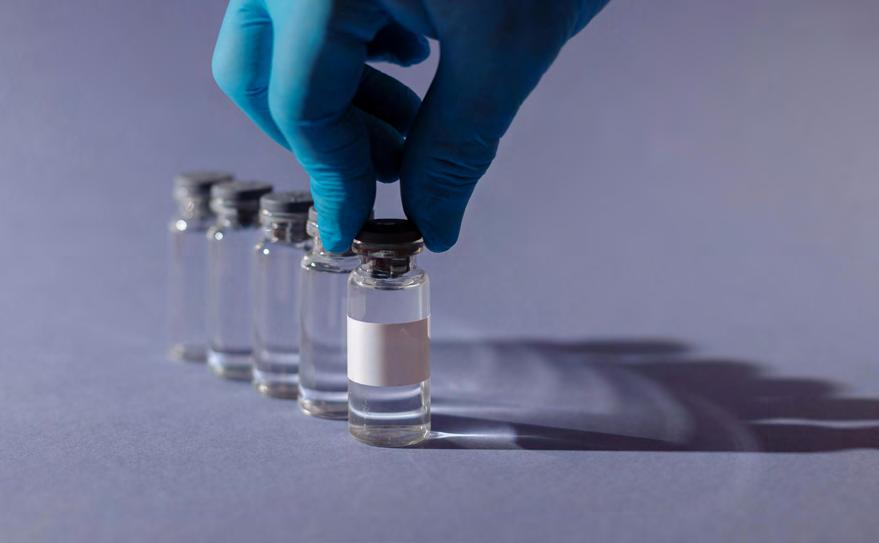

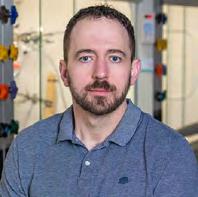
Professor Matt Webber, a biomedical engineer, is working to make insulin smarter. Funded by the Type 1 Diabetes Grand Challenge, he is leading the development of next-generation insulins, which respond in real time to blood sugar levels. His research could lead to safer, more precise treatments and bring us closer to automated glucose control for people with T1D.
Can you tell us a bit about your background and what led you to become a biomedical engineer?
I started out in chemical engineering because I was fascinated by the idea of designing materials from the molecular level. Over time, became especially interested in how those materials could interact with the human body. That interest led me to pursue a PhD in Biomedical Engineering, where I focused on chemistry and materials science as tools to develop better biomaterials and drug delivery systems.
What inspired you to focus your research on type 1 diabetes and the development of new types of insulin?
Managing type 1 diabetes takes a tremendous amount of daily effort, constant attention, planning, and mental energy. I was drawn to the idea of developing more autonomous
therapies that could help ease that burden. For this to work, the system needs to be incredibly precise, delivering just the right dose at just the right time to safely control blood sugar. Designing insulin and glucagon therapies that respond automatically to changes in glucose levels felt like a really exciting and meaningful challenge where our science could have a real impact.
What does a typical day look like for you in the lab?
No two days are exactly the same, but I usually spend time checking in with students, discussing experiments, analysing data, and planning next steps. I’m constantly thinking about how we can improve our technologies, identify remaining challenges, and move closer to clinical use. Each day brings a new mix of science, mentoring, problem-solving, and deadlines and that variety is what makes the work so engaging and rewarding.


You’re developing a ‘smart insulin’ that responds to blood sugar levels. How does this technology work?
You can think of our technology as giving insulin a built-in sensor. It stays mostly ‘off’ when blood sugar is in a healthy range, but turns ‘on’ and begins working as glucose levels rise. The big-picture goal is an insulin that responds automatically as needed to keep blood sugar in check. A more practical near-term goal might be a single insulin that can cover both basal and mealtime needs by varying its potency. That way, people can dose more confidently without constantly calculating or worrying about going low.
What are the next steps to bring your smart insulin from the lab to people living with T1D?
We’re focused on making the system more reliable and consistent, including testing it under real-world conditions like exercise or missed meals. We’re also working to ensure it is stable, safe, and suitable for repeat dosing. Eventually, we’ll need to collaborate with industry partners to scale up production and with clinical teams to begin human trials. There’s still plenty of work ahead, but we’re making steady progress toward bringing better therapies to people.
What has been the most rewarding moment in your research journey so far?
One of the most rewarding parts of my job is mentoring students and watching them grow into independent scientists. But what motivates me just as much is the hope that our work can lead to real improvements in people’s lives. often speak with
parents of children with type 1 diabetes, and I see how much they’re counting on us to create safer, better therapies. That hope is powerful, yet it comes with a deep responsibility to turn it into something real. That’s what keeps us going.
Has anything surprised you about your research so far?
We might design a system with a very specific function in mind, but once it interacts with the body, things don’t always go according to plan. At first that can be frustrating, but more often than not, it opens the door to unexpected insights. Those moments when the biology teaches us something new can be the most fascinating and valuable parts of the process.
What keeps you motivated in your work, especially when things get tough?
It’s the challenge that drives us. If this work were easy, it probably wouldn’t be worth doing. People are counting on us to raise the standard of care, and the possibility that what we’re building could help them is all the motivation we need to keep going.
What message would you like to share with families and people living with type 1 diabetes?
We’re driven every day by the goal of delivering better options for you and your loved ones. Our team is working hard to create tools that make managing T1D simpler and safer. Until a real and lasting cure is realised, which I hope is not far off, we’ll keep working to improve the treatment options available now.
Find out more about novel insulins research at type1diabetesgrandchallenge.org.uk/novel-insulins

We’ve partnered with Barbie to design a doll who celebrates the T1D community.
Every child deserves to grow up in a world where they feel seen, understood, and valued. For people living with type 1 diabetes, that sense of belonging can sometimes be harder to find. Representation, whether in books, media, or everyday play, has the power to change that. It not only helps children feel more confident in who they are but also encourages understanding and awareness among their peers.
Our Barbie is part of the Fashionista range and is dressed in a blue polka dot dress which represents a blue circle, the global symbol for diabetes awareness. Barbie uses a CGM and insulin pump to manage her T1D and carries a smart phone to check her levels in her handbag.
Barbie with T1D was launched globally in early July, with a social media campaign. Media coverage spanned across the world, with Barbie featured across all major news outlets. Lila Moss, model and Breakthrough T1D supporter, led the launch in the UK with her own Lila Moss Barbie saying: “I am proud to use my platform to educate around type 1 diabetes and show that being different is cool. Receiving messages from people who see my patches and feel represented means everything to me. To be able to now see Barbie dolls with T1D, and to receive a Barbie doll that visibly looks like me even wearing her patches, is both surreal and special.”
In the US, T1D Barbie was launched at the Breakthrough T1D Children’s Congress with each delegate receiving a doll. This collaboration is a unique opportunity to bring visibility and awareness of T1D. Barbie comes in a co-branded box and beyond her impact on children, Barbie’s branding helps shine a light on our work to support everyone with T1D and brings our mission to a new generation of families and supporters.
You can purchase your own Barbie from major retailers including Smyths, Amazon, The Entertainer, Very and Argos.


I’m absolutely thrilled that Barbie now includes a doll with type 1 diabetes. As a beloved icon for children everywhere, it’s wonderful to see Barbie proudly reflecting T1D and the technology that comes with it. For children with T1D who don’t often see themselves represented, this doll will be a powerful role model, celebrating their strength and bringing recognition, inclusion, and joy to their play
Karen Addington MBE, CEO of Breakthrough T1D

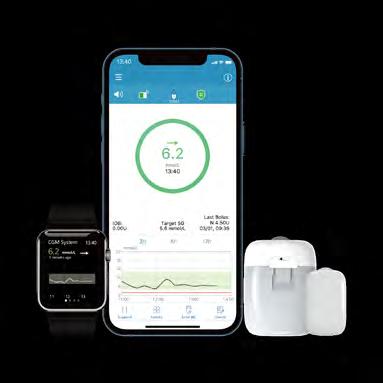



Thanks to ongoing funding and support from Breakthrough T1D, Professor Colin Dayan at Cardiff University and his team of international researchers have set up a clinical trial called T1D-Plus, to test multiple drugs to treat type 1 diabetes in parallel and in combination with each other.
We know that type 1 diabetes (T1D) develops over time and that early intervention is crucial, as preserving beta cell function during this period can lead to better long-term outcomes. Treatments that can slow down or prevent the immune system attacking beta cells have huge potential to prevent and treat T1D.
Clinical trials are used to help researchers understand if a new treatment or intervention is better or safer than current treatment options. However, clinical trials are expensive, time-consuming and resource intensive. This is why Professor Dayan and his team have designed the T1D-Plus trial a bit differently. T1D-Plus is what is known as a ‘platform trial’. In these trials, many drugs or treatment combinations are tested and compared at the same time and parts of the trial can be adapted as it progresses. For example, if a
drug combination is proving unsuccessful, this part of the clinical trial can be stopped, so that no more patients get that treatment. New drugs and combinations can be added to the clinical trial too. This approach helps researchers understand how different therapies interact and which combinations are most effective. Platform trials are commonly used by researchers when testing cancer drugs, but they were also used during the COVID-19 pandemic response to rapidly identify potential treatment options. This will be the first time a platform trial has been used to assess treatments for T1D.
Professor Colin Dayan at Cardiff University said: “This is the first trial of its type ever conducted in T1D. We will be able to test several different treatments at the same time, allowing us to get answers more quickly. An extra unique feature of this study is that everyone who takes part will receive at least one treatment to help preserve their insulin making cells - there is no ‘placebo’ group in this study.”
Researchers have identified several different drugs that are able to slow the autoimmune attack on insulin-making beta cells in the pancreas. Now researchers want to understand if, by using a combination of these drugs, they can slow down the autoimmune process even more, enabling people to keep making their own insulin for longer. The researchers will be testing the safety and effectiveness of multiple drugs, both on their own and in combination at the same time.
Most people understand the importance of medical research, but taking part in a clinical trial can be daunting, not least because the process can seem overwhelming if you don’t know what to expect. Generally, taking part in a clinical trial gives people the chance to access potential new treatments and/or testing that is not usually available to someone with their condition.
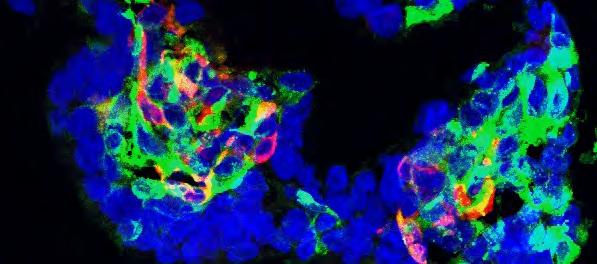

T1D-Plus is looking at adults aged 18 to 44 who have been diagnosed with T1D in the previous six-weeks. After initial screening, people will be randomly allocated to one of four treatment groups and will be told which treatment(s) they are receiving.
Everyone taking part in T1D-Plus will be given a daily verapamil tablet. Verapamil is a well-known drug used to treat heart conditions like high blood pressure and angina (chest pain). Research funded by Breakthrough T1D found that verapamil can slow T1D progression and preserve the ability to make insulin.
Most people taking part will receive an additional treatment alongside their daily verapamil pill. One group will be given verapamil plus golimumab injections, an immunotherapy that is used to treat the autoimmune conditions rheumatoid arthritis and ulcerative colitis. Another group will receive verapamil plus antithymocyte globulin (ATG) infusions, an immunosuppressant drug used in organ transplants. A fourth group will receive an additional daily tablet of baricitinib, a drug given to people
with rheumatoid arthritis and alopecia that one of our clinical trials found can preserve insulin production in people with T1D.
This clinical trial will run for twoyears, with everyone being treated during the first 12-months, and an additional, optional 12-months for follow-up visits. During that time, researchers will measure changes in beta cell function and use this to track the progression of T1D over time.
T1D-Plus is a multinational trial, supported by Breakthrough T1D and facilitated by the INNODA network. It brings together expertise from across the areas of immunology, beta-cell biology, biomarker research and T1D therapy. Through pooling resources, we aim to accelerate the development of effective therapies that can alter the course of T1D.
Together, we’re making this vital research possible
Why this matters to all of us
Although this trial focuses on people who are newly diagnosed, the lessons it teaches us will benefit the entire T1D community. We are moving into a new era of treatment, where protecting or restoring beta cells is a major focus. Future treatments will rely on our ability to keep beta cells alive and functioning. T1D-Plus is helping to lay the scientific groundwork to make that possible.
We want to thank every Breakthrough T1D supporter reading this. Whether you donate, fundraise, share your story or take part in research, your involvement drives every breakthrough we achieve. T1D-Plus is possible because of you. And to everyone considering clinical trial participation, you are at the heart of discovery. By volunteering, you are helping to test treatments that could change lives, not just for you, but for thousands of others. It is one of the most powerful ways to contribute to our shared goal of a world without type 1 diabetes.
For more information about how to get involved in research visit breakthrought1d.org.uk/take-part-in-research
Living with type 1 diabetes means being aware of how it can affect different parts of your body, including your kidneys.
Your kidneys do the important job of filtering waste and extra fluid from your blood. Over time, things like high blood sugar and blood pressure can put stress on those tiny filters. The good news? Regular check-ups can help spot early signs, like protein in your urine, before any problems start to affect your overall health. Knowing what to look for and how to take care of your kidneys puts you in control.
In the early stages, kidney damage usually doesn’t cause any noticeable symptoms. That’s why annual check-ups are so important. Your diabetes care team should carry out two key tests:
• A urine test to check for protein (called albumin) or blood in your urine.
• A blood test to measure a waste product called creatinine and calculate your eGFR (estimated glomerular filtration rate), which shows how well your kidneys are filtering.
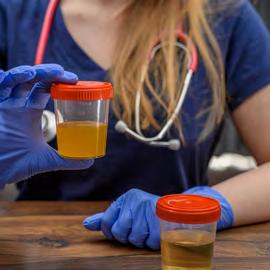
As kidney damage progresses, you might start to notice symptoms like:
• Tiredness
• Swollen ankles, feet, or hands
• Shortness of breath
• Feeling sick
• Blood in your urine
• Foamy or bubbly urine
If you experience any of the above symptoms speak to your GP or Diabetes Healthcare Team as soon as possible. They will have a plan to help protect your kidneys.
Early diagnosis is key. If your annual tests show any signs of kidney problems, your healthcare team can help you take steps to slow or even stop the progression of damage. Here are some other helpful tips:
• Keep your blood glucose levels in your target range as best you can
• Manage your blood pressure where possible
• Eat a balanced diet that’s low in salt
Find out more about more about living with type 1 diabetes at: breakthrought1d.org.uk/living
• Stay active
• Avoid smoking
“[I had] no idea of kidney disease being a complication and the damage done to kidneys by diabetes”
– Patient/lived-experience interview, Kidney Research UK
Where
to go for more support
Your GP or Diabetes Healthcare Team can provide advice and support for kidney health. You can also find more information about kidney disease and diabetes on the Kidney Research UK website.
Research to prevent and treat T1D complications is central to our mission. Breakthrough T1D UK-funded scientists have identified genes that predict diabetic kidney disease progression, and other research has discovered early biological markers that could enable earlier diagnosis and treatment. If you want to learn more about our kidney research, you can read a new paper coauthored by Breakthrough T1D, Diabetes UK, and Kidney Research UK, which has identified six themes to tackle diabetic kidney disease.
Emmie’s 5-year journey with type 1 diabetes. Matt Buxcey, Emmie’s dad, tells her story.
Meet Emmie, a bright, happy seven-year-old who’s bursting with energy. She was diagnosed with type 1 diabetes at 14 months, so a CGM is a part of her full and active life. Emmie is naturally confident and loves dancing, gymnastics, and attending theatre classes.
When she was at nursery, continuous glucose monitoring gave us peace of mind. As the start of school was approaching, we realised that a hybrid closed loop system was the most effective way to manage her constantly-changing glucose needs. It gives her the freedom to carry on as normal and as parents, we feel secure knowing that her glucose levels are under control.

Her FreeStyle Libre 3 sensor is discreet1, it stays in place and we find it easy to regulate her levels. From Emmie’s point of view, she’s thrilled to take part in all her activities without parents hovering around!
Here’s to a bright future!


















Volunteers bring energy, experience and heart to their roles at Breakthrough T1D. Whether they’re supporting teams behind the scenes or connecting directly with the community, their contribution is vital. In this issue, we hear from MJ and Bob, two inspiring volunteers who are finding meaning and motivation in giving their time to support others.
MJ:
“I’m so proud of myself right now”
“I work full-time as a chef in London, and I’ve recently started volunteering with the Events and Supporter-Led Fundraising team at Breakthrough T1D. I’ve been thinking about making a career move into project management, but I know how tough it can be to break into a new field without experience. So, I decided to dedicate time to building that experience and when I saw this volunteer role advertised, I checked out Breakthrough T1D’s website. The charity instantly resonated with me.
My mum has diabetes, and I know how tough it is to live with. People should help one another, so why shouldn’t help? I feel like I’m making a real difference here.
The Events team welcomed me straight away. From day one, they’ve treated me like an equal, and it’s been amazing to be part of such a supportive, passionate group. Their enthusiasm has definitely rubbed off on me. What I’ve loved most about volunteering is the positive vibe. like to get things done in a great atmosphere, and the team has given me room to do that. I’ve also found it incredibly motivating to work with a successful, all-female team. I can see women achieving great things and it’s helped me believe I can do that too. That’s not something I really get in my job as a chef, where I’m the only woman in the kitchen. In just a short time, the team has trusted me with meaningful tasks that have taught me new skills and boosted my confidence. I’ve helped with everything from answering participant emails to liaising with suppliers and handling admin. I juggle everything and I love it!
I’ve also developed a whole new appreciation for event planning. I’m used to things happening behind the scenes in a kitchen, but this has unlocked a new level of respect for the people working behind the scenes to make events a success.
Knowing that my work is helping people living with type 1 diabetes is amazing. Honestly, I’m so proud of myself right now.
I look forward to every Wednesday. I’d volunteer with Breakthrough T1D over and over and over again. It’s that fulfilling.
To anyone considering volunteering, I’d say: do it! You don’t need loads of free time – just a willingness to get involved. You’ll gain confidence, new skills, and feel valued while supporting a good cause.
Looking ahead, I’m hoping to move into a paid role in project management, but I’d still love to volunteer alongside
that. For me, the most important thing is giving my time to a good cause and helping others. We’re all here in this world.
Think about your impact. What legacy will you leave behind?
I don’t know the people I’m helping, but I’m putting in my time, and that’s my way of making a difference.”
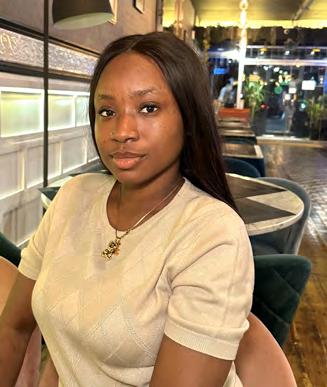
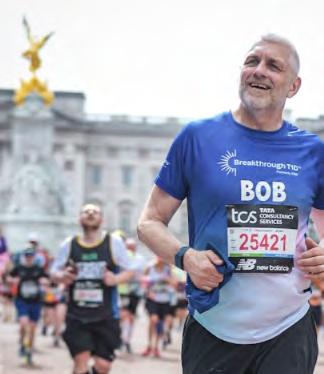
Bob: “You only get one shot at life. If I can help them, I will.”
“I live with type 1 diabetes and over the past year, I’ve taken on a new role as a Community Connector with Breakthrough T1D. When I saw that the Community Engagement team were looking for volunteers to support their work, I felt it was the right time to step up and give something back.
The Community Connector role was new when I joined, so I’ve been learning as I go. There are three key parts to it: supporting healthcare professionals (HCPs), using my own experience to help others living with type 1, and representing Breakthrough T1D out in the community. One highlight for me was attending a National Networking Forum for HCPs alongside Lesley, who leads on technology access. It was powerful to see how I could help HCPs in both primary and secondary care become more aware of what Breakthrough T1D offers, and the support available for people with T1D.
Earlier this year, I represented Breakthrough T1D at a charity evening hosted by a local ladies’ National Farmers’ Union group. I gave a talk about the charity and accepted a donation they had raised
My mum has diabetes, and I know how tough it is to live with. People should help one another, so why shouldn’t I help? I feel like I’m making a real difference here
I also went to a Discovery Day event, and that really opened my eyes. Seeing people who knew so little about how they could better manage their diabetes made me want to do more. It struck me how often we assume everyone has the same knowledge, but that’s not the case.
Earlier this year, I represented Breakthrough T1D at a charity evening hosted by a local ladies’ National Farmers’ Union group. gave a talk about the charity and accepted a donation they had raised. I thought, “It’s on my doorstep. Why not?” It was a great opportunity to say thank you and raise awareness at the same time.
Volunteering isn’t new to me. I’ve been involved with my local rugby club for over 20 years in all sorts of roles. But as I’ve got older, I’ve started thinking more about what really matters in life. And for me, that’s helping others. You only get one shot at life, and I know there are people out there who are struggling to understand their condition. If I can help them, I will.
Volunteering with Breakthrough T1D has helped me reevaluate what’s important. This work matters to me not only because I live with T1D, but because my daughter does too. It’s made me shift my focus and spend more time on things that truly make a difference.
I also ran the London Marathon this year to raise funds for Breakthrough T1D. That, to me, is just as much volunteering as anything else. It takes time, training, and commitment. One of the best parts was being part of the Breakthrough T1D marathon WhatsApp group. Some of us have T1D, some don’t – but everyone’s learning from each other. It’s brilliant for understanding and connection.
Looking ahead, I’m really passionate about building a local T1D community. Something like the diabetes online community, but face-to-face. With help from my diabetes consultant, I’m working to get something going locally. I’ll be really proud when it comes together.
If you’re thinking about volunteering, I’d say: just do it. Jump in first and figure it out. You’ll find that people are supportive and genuinely care. Hearing about the amazing things other volunteers do makes me value myself more and that’s a pretty powerful thing!”
To find out more about volunteering at Breakthrough T1D visit breakthrought1d.org.uk/volunteer
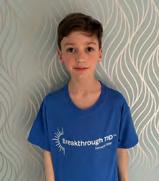
Archie Pearce
We’d like to say a big thank you to eight-yearold Archie Pearce who raised over £4,000 for Breakthrough T1D! Archie, who was diagnosed with T1D last year, did a virtual 50 mile walk across 50 countries on his VR headset. Well done!
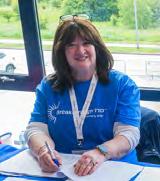
Catherine Purcell
Thank you to Catherine for her incredible support on the Scotland Ball committee, securing prizes for events, and generously volunteering her time. Her dedication, enthusiasm, and willingness to pitch in make a huge difference to our work.
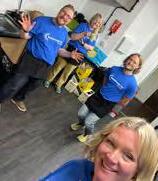
Nin Vesty
Thank you to Nin for her tireless volunteering and commitment to our events. Her hard work behind the scenes is the reason many of them have been such a success. We’re so grateful for her dedication and passion.
Take on the tallest freestanding mountain in the world – a challenge like no other and the experience of a lifetime.
Help us build a team, all raising vital funds to treat , prevent and cure T1D!

Your passion and support make our vital work possiblethank you!

The Harrowers
A heartfelt thank you to The Harrowers for their unwavering support, from powering our Quiz for a Cure event to reviving Harroween this winter. Your time, energy, and commitment to Breakthrough T1D mean the world to us.
People living with type 1 diabetes who currently use FreeStyle Libre 2 and FreeStyle Libre 3 sensors will be upgraded to FreeStyle Libre 2 Plus and FreeStyle Libre 3 Plus sensors by the end of 2025. FreeStyle Libre 2 sensors will be discontinued at the end of August so people need to ask for their prescriptions to be updated now to FreeStyle Libre 2 Plus FreeStyle Libre 3 sensors will be discontinued at the end of the year and replaced with FreeStyle Libre 3 Plus sensor which has a 15-day wear time and is licenced for people living with type 1 diabetes from the age of two years and above.
FreeStyle Libre 3 Plus sensors will be offered on NHS prescription and cannot be self-funded.
If you’re currently using the FreeStyle Libre 2 or FreeStyle Libre 3 sensor, speak to your healthcare provider to see which new sensor is best for you and replace your prescription. These upgrades are already embedded in the GP prescribing system so the switch should be seamless. Users of FreeStyle Libre 2 or FreeStyle Libre 2 Plus sensors need to make sure they are running the latest version of the FreeStyle LibreLink app, which is version 2.12.0.


To join, scan the QR code below, or email events@breakthrought1d.org.uk for more information.
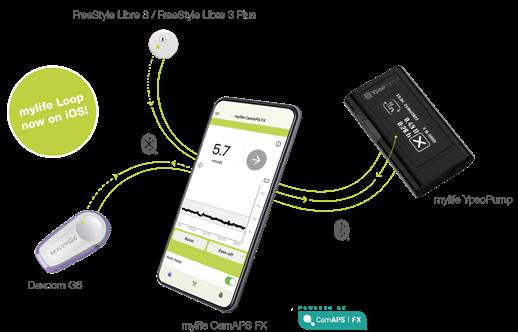
The Mylife CamAPS FX app, which works with the Mylife YpsoPump insulin pump and either the FreeStyle Libre 3 Plus or Dexcom G6 glucose sensor to form a hybrid closed loop system, is now available for iPhones on the Apple Store. Before, it was only available for Android, but now users can choose to use it on either iOS or Android.

Connect with the T1D community, share stories and tips, raise funds and have fun when you join a Breakthrough T1D event. For full details and to view the latest list, visit breakthrought1d.org.uk/events
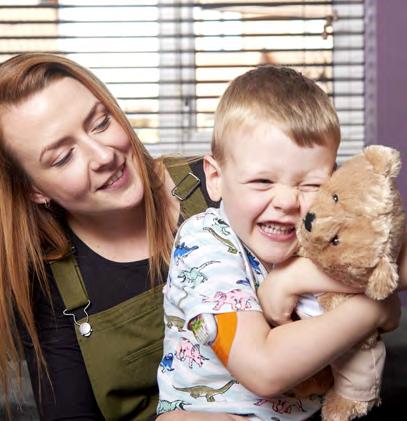
We are extremely grateful for any gift – large or small – that you leave to Breakthrough T1D to help us find ways to cure, treat and prevent T1D. In return, we make these promises to you:
• We always understand your family and friends come first, just as they should.
• We will use your gift carefully and cost-effectively, so it has the greatest research impact possible.
• We would love to know if you decide to leave a gift in your Will, so we can say thank you. But we respect your privacy and if you prefer to let us know anonymously, or not at all, then we do understand.
• You never need to tell us what or how much you want leave to Breakthrough T1D. Simply letting us know you have made such a special and important gift is very helpful.
• You can change your mind at any time. Even if you tell us you plan to leave a gift in your Will to Breakthrough T1D, it is not legally binding.

Gifts in Wills are powering research around the world to build a brighter future for everyone living with T1D. To find out more about leaving a gift in your Will, you can download your free legacy pack by visiting breakthrought1d.org.uk/legacy or by scanning the QR code










































1 Here is my gift of…. £10 £ 25 £50
Other
2
Please make any che que payable to Breakthrough T1D To give by M asterc ard/ Vis a (delete as appropriate) please f ill in b elow: Card no.
3 Your details Name:
Address:
Postcode:
4 Keep in touch
To sign up to our emails and hear about the latest type 1 research, news, events and how you can help advance our work please complete your email address below:
You can change the way we contact you at any time by calling us on 020 7713 2030
5 Gift Aid
Yes I want to increase the value of my donation to BreakthroughTD1 by 25% at no extra cost.
Yes, I want to increase the value of my donation to Breakthrough T1D by 25% at no extra cost I am a UK taxpayer and want to Gift Aid this donation and any donations I make in the future or have made in the past 4 years to Breakthrough T1D. I understand that if I pay less Income Tax and/or Capital Gains Tax than the amount of Gift Aid claimed on all my donations in that tax year it is my responsibility to pay any difference
D ate: I am not a U K t ax p aye r
Thank you. Please return your form in the freepost envelope provided or to Freepost RTYC-XAJB-ZGUG, BreakthroughT1D, 17/18 Angel Gate, City Road, London EC1V 2PT.
or call
on 020 7713 2030
We understand that deciding to include a gift in your Will is a very personal decision. But if you are happy to let us know your plans it would be a great help. Anything you tell us is strictly confidential.
I am considering leaving a gift in my Will I intend to leave a gift in my Will
I have already left a gift in my Will
To find out more about leaving a gift in your Will, you can download your free legacy pack by visiting breakthrought1d.org.uk/legacy or by scanning the QR code


“Children should never have to struggle with type 1 – it’s so important to come up with a cure and better tre atments. I want to le ave a gift in my Will to help”
Margaret grandmother to Fleur who was diagnosed with type 1 aged 9
Please return your form in the freepost envelope provided or to Freepost RTYC-XAJB-ZGUG, Breakthrough T1D, 17/18 Angel Gate, City Road, London EC1V 2PT
Breakthrough T1D Ltd is a charity registered in England and Wales (No 295716) and in Scotland (No. SC040123) Registered as a company limited by guarantee, in England and Wales (No 2071638) Registered address as above